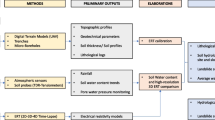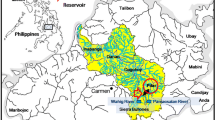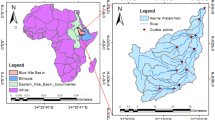Abstract
The effects of urban stormwater on the soil of an infiltration/ holding basin were studied within the framework of research carried out by OTHU (Urban Hydrology Field Observatory of Lyon, France). The biophysicochemical impacts of stormwater from an industrial watershed on the local soil (to a depth of 4 m in the unsaturated zone) were measured. Several types of measurement (pH, organic matter, particle size, heavy metals content, and heterotrophic viable bacterial counts) for three vertical soil profiles were carried out. High concentrations of heavy metals and significant variations in pH and silt to a depth of 1.5 m were observed. The concentrations decreased as a function of distance from the stormwater discharge pipe. Changes in the bacterial population were also observed, varying in accordance with the depth and location of the profile.
Résumé
Dans le cadre de la fédération de recherche OTHU (Observatoire de Terrain en Hydrologie Urbaine de Lyon) une étude sur l’impact des eaux pluviales sur le sol d’un bassin d’infiltration / rétention est présentée. Il s’agit d’évaluer l’impact biophysicochimique des eaux pluviales issues d’un bassin versant industriel sur une profondeur d’environ 4 m de zone non saturée. Pour cela plusieurs types de mesures ont été effectuées (pH, perte au feu, teneur en Cu, Pb, Cd, dénombrement bactérien) suivant trois profils verticaux. Les résultats montrent des concentrations importantes de métaux et des variations de pH jusqu’à 1.5 m de profondeur. De plus, les résultats montrent une variation suivant la position des points de prélèvements. Des modifications de la population bactérienne sont également observées suivant la profondeur et l’emplacement des profils.
Resumen
Se estudiaron los efectos de tormentas en zonas urbanas sobre el suelo de una cuenca retenedora/de infiltración dentro del marco de investigación llevado a cabo por OTHU (Laboratorio de Observación de Campo de Hidrología Urbana, Lyon, Francia). Se midieron los impactos biofisicoquímicos de la tormenta en una cuenca industrial sobre el suelo local (a una profundidad de 4m en la zona no saturada). Se llevaron a cabo varios tipos de mediciones (pH, materia org´nica, tamaño de partículas, contenido de metales pesados, y conteo de bacterias viables heterotróficas) en tres perfiles ed´ficos. Se observaron altas concentraciones de metales pesados y variaciones significativas en pH y limo a una profundidad de 1.5m. Las concentraciones disminuyeron en función de la distancia del tubo de descarga de las aguas de la tormenta. También se observaron cambios en las poblaciones de bacterias los cuales variaban en función de la profundidad y localización del perfil.









Similar content being viewed by others
References
Appleyard SJ (1993) Impact of stormwater infiltration basins on groundwater quality, Perth metropolitan region. W Australia Environ Geol 21:227–236
Barraud S, Gibert J, Winiarski T, Krajewski JLB (2002) Implementation of the monitoring system to measure impact of stormwater runoff infiltration. Water Sci Technol 45(3):203–210
Bourg ACM, Kedziorek MAM (1999) Geochemical filtering of heavy metals by calcareous alluvions in an island of the Seine River. Environ Technol 20:1183–1188
Burgeap (1995) Le Grand Lyon-Direction de l’eau. Etude de la nappe de l’Est lyonnais. Study of the East Lyon Groundwater, Greater Lyon Water Department, Greater Lyon, p 65
Chebbo G (1992) Caractérisation des solides des rejets pluviaux caractérisation et traitabilité (Characterisation of the solids in suspension in the urban rejections in rainy weather). PhD Thesis, Ecole Nationale des Ponts et Chaussées, France, 413 pp
Dean JR, Butler O, Fisher A, Garden LM, Cresser MS, Watkins P, Cave M (1998) Atomic spectrometry update: environmental analysis. J Anal At Spectrom 13:1R–56R
EN 12879 (2000) Characterization of sludges: determination of the loss of ignition of dry mass. IHS, Englewood , CO
Ford M, Tellam JH, Hughes M (1992) Pollution-related acidification in the urban aquifer, Birmingham, UK. J Hydrol 140:297–312
Hewitt AD, Reynolds CM (1990) Dissolution of metals from soils and sediments with a microwave-nitric acid digestion technique. At Spectr 11(5):187–192
ISO 10390 (1994) Soil quality-Determination of pH, ISO, Geneva
ISO 10693 (1995) Soil quality-Determination of carbonate content, ISO, Geneva
ISO 13320 (2000) Particle size analysis-Laser diffraction methods, ISO, Geneva
Lamble KJ, Hill SJ (1998) Microwave digestion procedures for environmental matrices. Analyst 123:103R–133R
Marsalek J, Brownlee B, Mayer T, Lawal S, Larkin GA (1997) Heavy metals and PAHs in stormwater runoff from the Skyway Bridge, Burlington, Ontario. Water Qual Resour Canada 32(4):815–827
Metting FB Jr (1992) Structure and physiological ecology of soil microbial communities. Soil Microbial Ecology: application in agricultural and environmental management, vol 1. Dekker, New York, pp 3–258
Mikkelsen PS, Weyer G, Berry C, Walden Y, Colandini V, Poulsen S, Grotehusmann D, Rohlfing R (1994) Pollution from urban stormwater infiltration. Water Sci Technol 29(1–2):293–302
Ministère de l ’Environnement (1997) Gestion des sites (potentiellement) pollués. Annexe 5-Valeurs-guides en matière de pollution des sols et des eaux (Management of the sites (potentially) polluted. Appendix 5: guidelines as regards pollution of soils and water). BRGM, Orléans, France, p 500
Mosley LM, Peake BM (2001) Partitioning of metals (Fe, Pb, Cu, Zn) in urban run-off from the Kaikorai Valley, Dunedin, New Zealand. N Z J Mar Freshw Res 35:615–624
NMHSPE (2000) Circular on target values and intervention values for soil remediation. The Netherlands Ministry of Housing, Spatial Planning and the Environment, http://www.vrom.nl/. Cited 1 July 2006
Paul EA, Clark FE (1996) Soil microbiology and biochemistry. Academic Press, San Diego, CA, p 340
Pilgrim W, Schroeder B (1997) Multi-media concentrations of heavy metals and major ions from urban and rural sites in New Brunswick, Canada. Environ Monit Assess 47:89–108
Ranjard L, Richaume A, Jocteur-Monrozier L, Nazaret S (1997) Response of soil bacteria to Hg(II) in relation to soil characteristics and cell location. FEMS Microbiol Ecol 24(4):321–331
Sposito G (1989) The chemistry of soil. Oxford University Press, New York, p 277
Yousef YA, Yu LL (1992) Potential contamination of groundwater from Cu, Pb, Zn in wet detention ponds receiving highway runoff. J Environ Sci Health 27(A):1033–1044
Acknowledgements
The authors would like to thank the OTHU research federation, Greater Lyon, CETE-Bron and the Rhône-Alpes Region of France, which provided technical and/or financial support for this research programme.
Author information
Authors and Affiliations
Corresponding author
Rights and permissions
About this article
Cite this article
Winiarski, T., Bedell, JP., Delolme, C. et al. The impact of stormwater on a soil profile in an infiltration basin. Hydrogeol J 14, 1244–1251 (2006). https://doi.org/10.1007/s10040-006-0073-9
Received:
Accepted:
Published:
Issue Date:
DOI: https://doi.org/10.1007/s10040-006-0073-9




